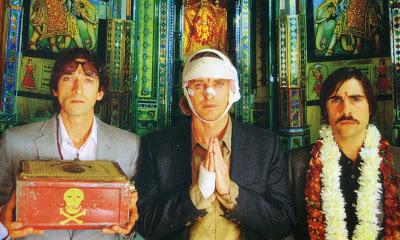
Still from The Darjeeling Limited
I'm going to quote unashamedly from an essay about Anderson by Pulitzer Prize winning author Michael Chabon (whose novel Telegraph Avenue is a must-read, by the way), because I think Chabon captures the essence of Anderson's movie-making mission most eloquently:"The world is so big, so complicated, so replete with marvels and surprises that it takes years for most people to begin to notice that it is, also, irretrievably broken...mortality, entropy, heartbreak, violence, failure, cowardice, duplicity, cruelty and grief. Everyone, sooner or later, gets a thorough schooling in brokenness. The question becomes: What to do with the pieces? Some people hunker down atop the local pile of ruins and make do; others set about breaking what remains of the world into bits even smaller and more jagged; and some people start to pick up a piece here, a piece there, with a vague yet irresistible notion that perhaps something might be done about putting the thing back together again.
"The most we can hope to accomplish with our handful of salvaged bits - the bittersweet harvest of observation and experience - is to build a little world of our own...a scale model of that mysterious original, unbroken, half-remembered. We call these scale models 'works of art'.
"In their set design and camera-work, their use of stop-motion, maps and models, Wes Anderson's films readily, even eagerly, concede the 'miniature' quality of the worlds he builds - and yet these worlds span continents and decades.
"Anderson's films understand and demonstrate that the magic of art, which renders beauty out of brokenness, disappointment, failure, decay, even ugliness and violence is authentic and honest to the degree that it builds its precise and inescapable box around its maker's scale version of the world. "For my next trick," says Wes Anderson, "I have put the world into a box."

Wes Anderson explaining a shot...
Anderson's methods are both intricate and painstaking, which is why he has only crafted eight movies in twenty years - but those movies are all of them brilliant stories and works of art in his distinctively quirky, engaging and very humane style. Take The Darjeeling Limited as an example. A significant part of the film (about three brothers seeking redemption and an absconded mother) is set on an Indian train (that gave the film its title) which, with the exception of the locomotive, was practically built from scratch for the production and everything was hand-made, right down to the hand-painted plates and hand-printed table-cloths in the restaurant car. Carriage walls had to hinge, to permit for distance shots to be set up, and girders were bolted into the ceilings to allow the cameras to track up and down corridors. As a final, self-referential touch, the outsides of the carriages were painted with stylised miniature scenes from the movie by local Indian artists - crazy and wonderful.Wes often plays bit parts in his movies (in the grand tradition leading back to Alfred Hitchcock); a student, a passenger on a bus, a commentator at a tennis match; I like that in Fantastic Mr Fox he chose as his cameo role the Weasel. His other influences (for the cineasts among you) are Orson Welles, Francois Truffaut, Louis Malle, Stanley Kubrick and Satjayit Ray - not a bad roll-call of influences. However, he has forged a directorial style all of his own.
Here's a resume of the world according to Wes - funny, clever, life-affirming depictions of the human condition. I you are urged to see them all (available on DVD, netflicks etc):
Bottle Rockets (1996), Rushmore (1998), The Royal Tenenbaums (2001), The Life Aquatic with Steve Zissou (2004), The Darjeeling Limited (2007), Fantastic Mr. Fox (2009), Moonrise Kingdom (2012) and The Grand Budapest Hotel (2014). His latest venture is another stop-action animation about dogs, currently in pre-production. I can't wait.
And so to this week's poem, with a bit of a preamble. The camera obscura (Latin for dark room) is a simple optical device that led to the development of the photographic camera and the whole evolution of still and moving pictures. It was originally a light-tight container with a pinhole in it that streamed the light and focussed a sharp (inverted) image, as shown in the diagram below - the world in a box.

Camera Obscura
Take one! Betrayal scene.
Pinpointed in the half-light
you lay stoned, naked
(martyr to your passion)
in this room,
this little world
in which you lost your head
in your magic friend's bed.
The camera panned,
picked out your hand,
a tan-line minus a wedding ring.
Little details.
What did it betoken,
folded in tissue
and tucked at the bottom
of your handbag,
with your conscience?
There are no more words to be spoken,
for this is now an awfully silent movie,
scripted, captured and canned -
and that's a wrap!
Thanks for reading. Have a popcorn-free, widescreen week, S ;-) Email ThisBlogThis!Share to TwitterShare to Facebook
Reactions:
